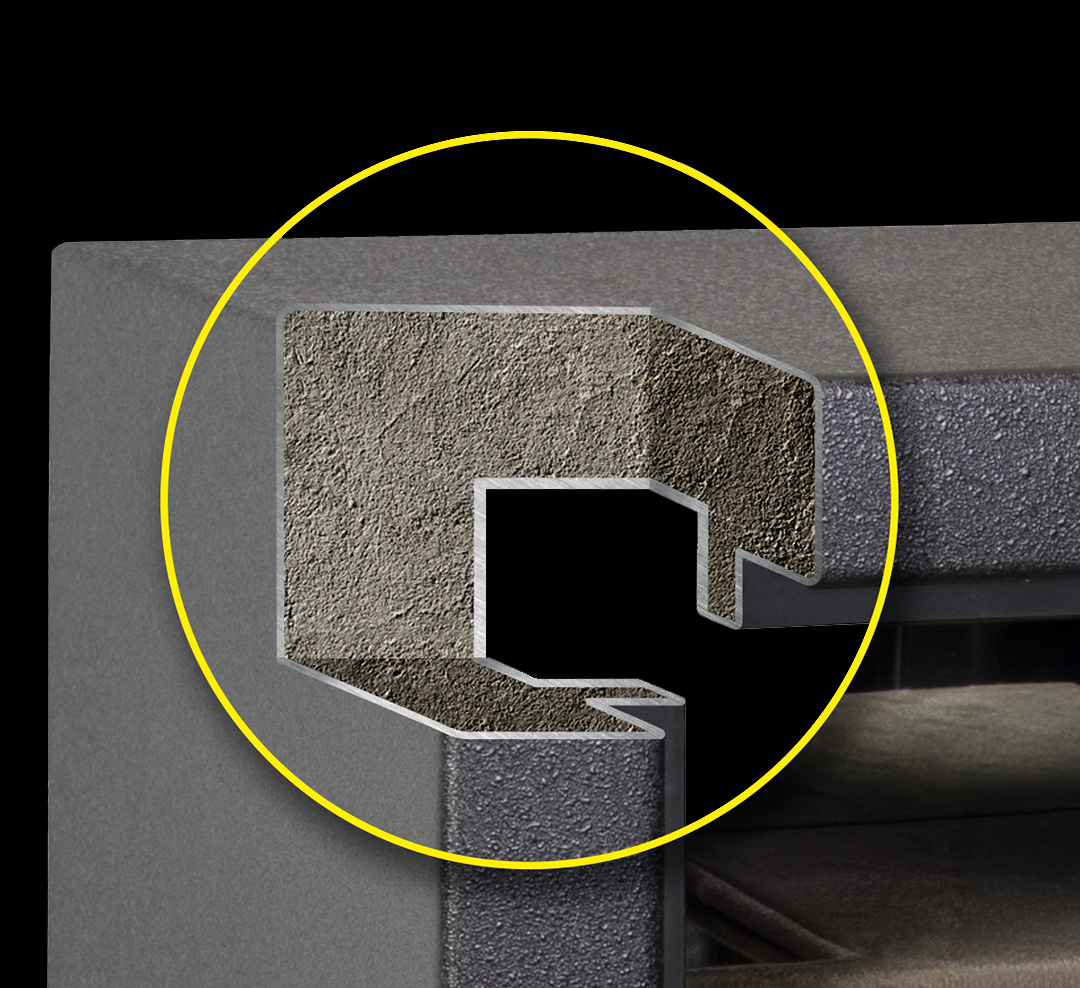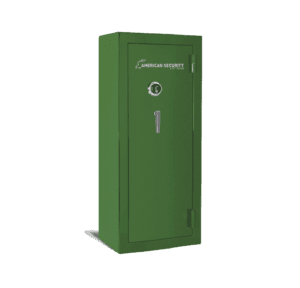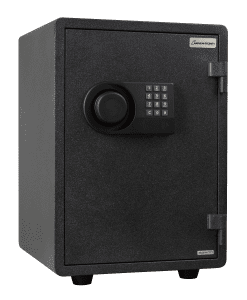If you’re in the market for a safe, you’ve likely seen many models advertised as fire-resistant. But what sets these safes apart from those without fire protection? The key lies in the fill materials used in their construction.
To help you make an informed decision, let’s break down some of the different types of fire-resistant materials used in safes, along with their advantages and limitations.
Best Fire-Resistant Safe Material: DryLight®
We couldn’t start this off without talking about American Security’s proprietary DryLight® material. DryLight® sets the gold standard for fire-resistant safe materials on the market. This is 19% lighter than drywall, which allows us to strategically incorporate thicker steel that heightens the level of security in safes using DryLight®.
Out of all the fire-resistant materials used in American Security safes, DryLight® provides the best defense against extreme heat and prolonged exposure to high temperatures. It offers continuous, seamless protection by filling the space between steel layers, ensuring there are no weak points where heat can penetrate.
Take a look at some of the American Security safes that feature this industry-leading material:
BFX Series – With enhanced security and an industry leading 2-hour fire rating, this model combines our DryLight® material with a rugged composite body.
Learn More About BFX Safe Series
BFII Series – Certified with an industry leading 2-hour fire rating, these models also feature DryLight® material and are the only UL RSC II security-rated gun safes on the market.
Learn More About BFII Safe Series
Fire Clay
Fire clay is another great fire-resistant material to consider after DryLight®. It provides consistent heat insulation and adds weight to the safe, offering significant burglary protection.
Fire clay is renowned for its exceptional heat resistance, making it a standout choice for high-temperature environments such as fires. Used in firebricks for kilns, furnaces, and chimneys, it boasts a remarkable melting point of 3,002°F. Unlike standard materials like drywall, fire clay is 43% denser, offering superior and long-lasting fire protection. Its durability ensures it holds up under extreme heat without breaking down, providing peace of mind where fire resistance matters most.
Here are the American Security safes that offer fire clay as a fire protection barrier.
BFS Series – With a 60-minute ETL fire rating at 1200°F, these safes are constructed with a Cement-based seamless fire and security barrier. With a few different sizes available, you can choose the right BFS safe that fits your current valuables and any future additions you’ll add to your inventory.
UL Series – This product line has UL’s stamp of approval with a 2-hour fire rating, withstanding 1850°F for that period. These models also undergo a drop test of 30’ (the equivalent of a 2-story building).
FS Series – Our FS safes are built with fire clay and are the only safes in their class that come with a UL-rated type 1 lock with a backlit keypad. With a UL fire rating of 60 minutes at 1700°F, this safe can give your cherished items a fighting chance during a house fire.
BF Series – Our BF safes come with a UL RSC Level 1 security rating and a UL fire rating of 60 minutes at 1700°F (BF3416 has an ETL fire rating of 60 minutes at 1200°F). These models will stand strong during forced entry attempts and unforeseen fires.
High Strength and Higher Strength Concrete
Concrete is another robust, fire-resistant material that is commonly used in high-security safes, particularly in our TL-rated models. Because concrete doesn’t burn, it’s an ideal fireproofing material. It also has heat-absorbing and dissipating properties, preventing the internal temperature of the safe from rising too quickly during a fire.
American Security utilizes two different types of high-strength concrete.
TL-15 Concrete (High-Strength Concrete)
- Has a PSI (pounds per square inch) of at least 6,300, making it 162% denser than standard drywall.
- Offers superior resistance to both heat and forced entry.
TL-30 Concrete (Higher-Strength Concrete)
- Has an even more impressive PSI of at least 9,300, making it 172% denser than drywall.
- Provides extreme durability against fire and high-impact attacks.
For context, a standard sidewalk has a PSI of around 2,500-3,000, meaning these safes use concrete that is at least three times stronger than what supports daily pedestrian and vehicle traffic.
Explore our large selection of TL-rated models to uncover the right safe that fits your needs.
Drywall
Drywall, also known as gypsum board, is one of the most commonly used fire-resistant materials in safes. Its fire protection capabilities come from gypsum’s natural composition, which contains water in its crystalline structure. When exposed to high temperatures, this water gradually evaporates, absorbing heat in the process and effectively slowing down the spread of fire. This helps maintain a lower internal temperature inside the safe for some time.
However, while drywall does offer some fire protection, it is not the most effective material for high-security safes. There are a few key drawbacks:
- Gaps in Construction: Drywall panels are often layered and pieced together rather than forming a seamless barrier. This can create small gaps where heat can infiltrate, reducing overall fire resistance.
- Lack of an Air-Tight Barrier: Unlike DryLight®, fire clay, or concrete, drywall does not form a completely sealed structure.
- Lower Durability: While it provides initial fire resistance, drywall lacks the structural strength of more advanced materials like concrete composites, making it a little more vulnerable during high-intensity fires or burglary attempts.
American Security Safes Featuring Drywall-Based Fire Protection
While American Security prioritizes high-performance fire-resistant materials, some models incorporate gypsum-based insulation to provide budget-friendly fire protection for homeowners and businesses.
AMSEC NF Series – Features multiple layers of drywall-based insulation, providing up to 90 minutes of fire protection at 1,200°F.
AMSEC TF Series – A more affordable option for residential security, these safes use drywall-based fire protection to withstand 30 minutes at 1,200°F.
While we mentioned some cons to drywall material, it’s still a useful option for those who may not need or want to invest in a high-security safe that offers the best fire rating. This material found in some of our safes has still passed some rigorous testing and has the potential to stand up to high heat.
Fire-Resistant Safe Materials and Burglary Protection
While fire resistance and burglary protection are often viewed as separate features, the materials used within a safe’s body can significantly impact both. A safe’s security rating is determined by its ability to withstand forced entry attempts, and its internal fire-resistant materials play a key role in reinforcing its overall strength.
For instance, DryLight® insulation, by itself, is specifically engineered for fire protection, not burglary resistance. However, when paired with thicker steel layers, it enhances the overall structural integrity of a safe, making it more resistant to prying, drilling, and impact attacks. This combination allows models like our BF and BFX Series to deliver both fire protection and a reinforced barrier against break-ins.
On the other hand, our TL-15 and TL-30 safes take security a step further by incorporating high-strength concrete composites. These models are built with thick steel walls and filled with high-density concrete, creating a solid core that resists cutting, drilling, and other forms of physical attacks. Concrete’s natural density and compression strength add an extra layer of difficulty for intruders attempting to breach the safe.
By choosing a safe that combines fire-resistant materials with high-security construction, you’re not just protecting valuables from heat—you’re investing in a safe that stands up against both fire and forced entry attempts.
How to Select the Best Fire-Resistant Safe For You
Choosing the right fire-resistant safe comes down to understanding your specific needs and priorities. Whether you’re looking for maximum fire protection, high-security burglary resistance, or a balance of both, the materials used in the safe’s construction will play a crucial role in its performance.
Consider the following factors when selecting your safe:
Fire Protection Needs
If you live in a wildfire-prone area or need to protect documents, valuables, or firearms from extreme heat, investing in a high-performance fire-resistant material like DryLight®, fire clay, or high-strength concrete can provide superior defense.
Security Level
If burglary protection is a top concern, opting for safes with thicker steel and high-strength concrete cores, such as TL-15 and TL-30 models, will offer the best resistance against forced entry.
Ultimately, the best fire-resistant safe is one that aligns with your security priorities and environment. By evaluating what matters most—whether it’s fireproofing, theft deterrence, or a combination of both—you can confidently select a safe that offers the protection and peace of mind you need.
By choosing an American Security safe, you can trust that both fire and burglary protection are built into every model. Our safes are engineered to withstand unforeseen threats, providing reliable defense against heat, theft, and forced entry, giving you peace of mind when it matters most.








